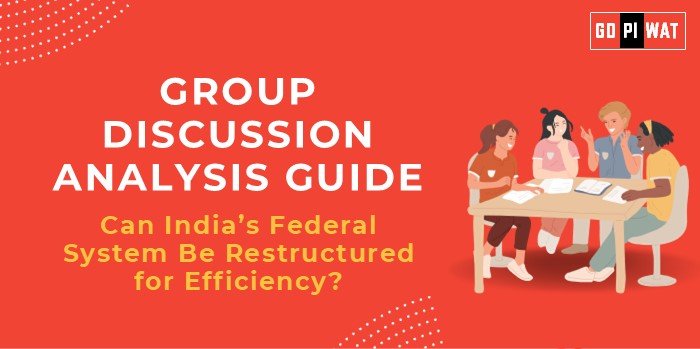📋 Group Discussion (GD) Analysis Guide: Can India’s Federal System Be Restructured for Efficiency?
🌐 Introduction to India’s Federal System
- 📖 Context: India’s federal structure balances a strong central government with empowered states, as enshrined in the Constitution of 1950. However, growing demands for efficiency in governance, resource allocation, and dispute resolution call for re-examination of this structure.
- 🌍 Topic Background: The Indian federal system reflects cooperative and competitive federalism. Recent debates on centralization versus decentralization have intensified with economic reforms, GST implementation, and COVID-19 management challenges.
📊 Quick Facts and Key Statistics
- 💰 State-Centric Spending: 60% of India’s public expenditure is executed by states.
- 📉 Fiscal Dependency: States rely on the Centre for 42% of their revenues (15th Finance Commission, 2021).
- ⚖️ Inter-State Disputes: Over 100 cases pending before the Supreme Court in 2024.
- 🌏 Global Comparisons: Countries like Germany and Canada demonstrate more devolved fiscal federalism.
🤝 Stakeholders and Their Roles
- 🏛️ Central Government: Policy formulation, revenue distribution.
- 🏢 State Governments: Local governance, welfare implementation.
- ⚖️ Judiciary: Arbitration of inter-state and Centre-state disputes.
- 👥 Citizens: Beneficiaries of efficient governance.
- 🌐 International Examples: Insights from federal structures in the USA and Australia.
🏆 Achievements and Challenges
✨ Achievements:
- ✅ Fiscal Reforms: GST streamlined indirect taxation.
- 📋 Cooperative Federalism: NITI Aayog enables collaborative planning.
- 🚶 Inter-State Coordination: Efforts like One Nation One Ration Card enhance mobility.
⚠️ Challenges:
- 📉 Vertical Imbalance: States struggle with over-centralization.
- 📑 Administrative Overlap: Duplication of functions leads to inefficiency.
- 🌏 Global Comparisons: Germany’s fiscal devolution outpaces India.
- 📄 Case Study: COVID-19 exposed disparities in healthcare capacities across states.
💡 Structured Arguments for Discussion
- 📢 Supporting Stance: “Restructuring India’s federal system can drive resource efficiency and align state policies with national goals.”
- ❌ Opposing Stance: “Overhauling a well-established system risks destabilizing governance and deepening state-Centre conflicts.”
- ⚖️ Balanced Perspective: “Targeted reforms addressing fiscal imbalances and administrative inefficiencies can modernize the federal framework without systemic risks.”
📌 Effective Discussion Approaches
🎯 Opening Approaches:
- 📊 Data-driven: “India executes 60% of its public expenditure through states but struggles with fiscal independence.”
- 📄 Case-based: “The prolonged Cauvery dispute exemplifies inefficiencies in the federal system.”
🔄 Counter-Argument Handling:
- ⚖️ “While centralization improves uniformity, it undermines local autonomy critical for diverse needs.”
- 🌏 “Global examples show devolution enhances governance, yet India’s cultural complexities require caution.”
📚 Strategic Analysis of Strengths and Weaknesses
- 💪 Strengths:
- 📜 Constitutional safeguards.
- 🤝 Cooperative mechanisms (e.g., GST Council).
- ❌ Weaknesses:
- 📉 Fiscal centralization.
- 📑 Unequal state capacities.
- ✨ Opportunities:
- 🌐 Leverage digital tools.
- 📋 Enhance inter-state coordination.
- ⚠️ Threats:
- 📢 Political polarization.
- ⚖️ Resistance to change.
🎓 Connecting with B-School Applications
🌐 Real-World Applications:
- 📊 Policy analysis projects on fiscal reforms.
- 📄 Case studies on NITI Aayog’s role.
❓ Sample Interview Questions:
- ❓ “How can fiscal federalism be optimized in India?”
- 💡 “What lessons can India draw from Canada’s federal system?”
📈 Insights for Students:
- 📖 Cross-disciplinary understanding of governance.
- 💡 Scope for innovation in resource allocation and dispute resolution.


